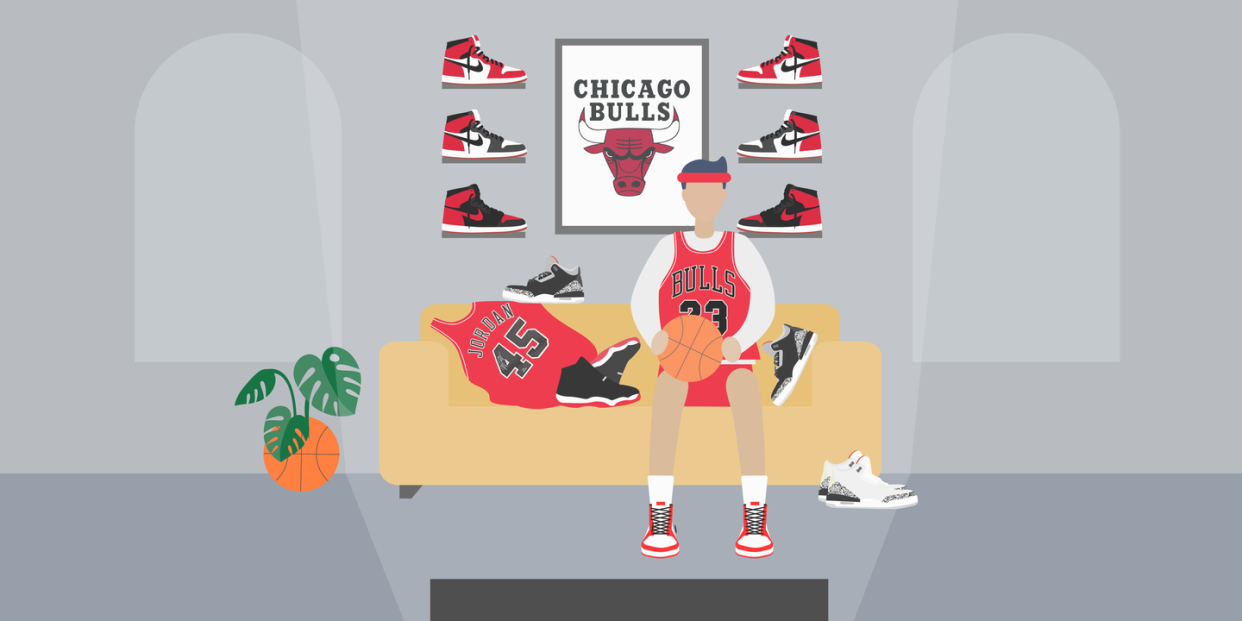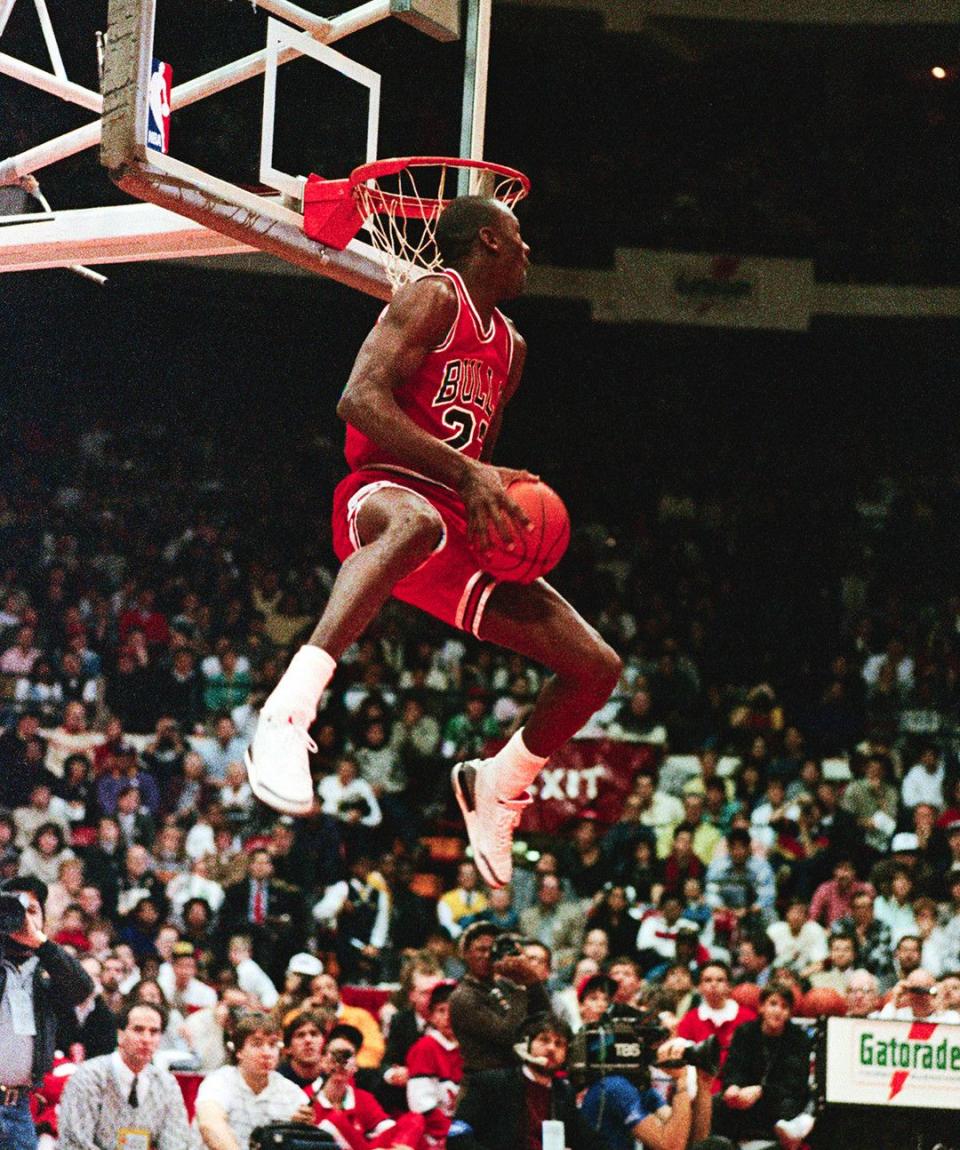How 'The Last Dance' Brought the Tunnel Walk to the Living Room


It’s become a ritual for Marvin Barias. The sneaker aficionado, who regards collecting Air Jordans as his professional career, has been digging through his deep stash of vintage shoes, clothes, and memorabilia every Sunday to pull out relics from his collection.
No, he isn’t prepping to do a giant dump of valuable items on the resale market. For the last four Sundays, Barias has been getting dressed in the gear at home to worship at the altar of Michael Jordan while watching ESPN’s 10-part docuseries The Last Dance.

“When I was a kid, I used to get riled up for a Bulls playoff game because you were rooting for Michael Jordan,” says Barias, who goes by the handle MJO23DAN on Instagram. If you couldn’t tell by his Internet moniker, he’s idolized Jordan for decades, and watching the episodes has rekindled his love for his childhood hero. “Whenever you see these games, it kind of transports me back to that time.”
The last time Michael Jordan wore a Chicago Bulls uniform in the NBA was 23 years ago, but the documentary has brought the icon, his teammates, his sneakers, and his signature hoop earring back into the spotlight. The series was originally supposed to air in June, but was moved earlier thanks to the plea of sports fans and the halting of organized national sports due to the Covid-19 pandemic.
“Given that everyone’s at home due to the virus, I think it’s exponentially blown up the impact,” says Marcus Jordan, Michael’s son and the founder and CEO of sneaker store Trophy Room. He makes several appearances in the doc, both as a child in old footage as well as an adult in the latter episodes. “I didn’t think it was going to be this big, with people chiming in and saying their two cents throughout the week.”
A post shared by Cindy Crawford (@cindycrawford) on May 3, 2020 at 8:44am PDT
Not only are sports pundits discussing decades-old news and debating hypotheticals on Sunday nights, but fans are getting dressed up in decades-old jerseys to do a tunnel walk into their living room. It’s not just hardcore sneaker collectors either. Celebrities (hi, Cindy Crawford) and NBA players are playing into it, too.
Dallas Maverick and Jordan Brand endorser Tim Hardaway, Jr. participates in the trend from home each Sunday. For the premiere, he pulled out a Jordan Olympic jersey that he’s had since middle school to pair with his Air Jordan 3s.
“I’m a fan too at the end of the day. People who don’t even watch basketball know who Michael Jordan is. Very few athletes carry that type of inspiration,” Hardaway, Jr. says, adding his admiration for Michael Jordan as a kid is what motivated him to rep Jumpman in the NBA. The brand also maintains that it hasn’t paid anyone to wear the gear of their namesake and post it on social media to support the documentary. “It’s kind of hard to describe, because he had such an impact on everybody’s lives, whether you played a sport or not,” says Hardaway, Jr. “I can only name a couple people that had that type of impact.”
A post shared by paolins_424 (@lil_song424) on May 11, 2020 at 5:12am PDT
For Victor Oladipo, the doc has registered more on emotional level than a sartorial one. The current generation Team Jordan athlete and All-Star for the Indiana Pacers says watching the last few minutes of the seventh episode, where MJ gives an impassioned soliloquy that explains his tyrannical way of motivating his teammates, was life changing to Oladipo as an NBA player.
“This is a tough time in the world with the coronavirus going on, but MJ is still bringing joy, not only to us as basketball players, but the entire world,” Oladipo says. “It’s something that only MJ could do, even with everything shut down, he still finds a way to inspire and entertain us.”
A post shared by Mark Surridge (@nineteen.85) on Apr 19, 2020 at 7:29am PDT
From the outside looking in, the uninitiated may not understand why people are wearing high-ticket items to watch TV on their couch, but rapper and co-host of sneaker show Full Size Run Trinidad Jame$ says that this is something that would’ve happened with or without a pandemic, maybe even more so without.
“People would’ve had Last Dance watch parties like they would for boxing. I mean, people have definitely done watch parties for less,” he says. Jame$ says he chose to wear vintage Bulls gear and even put a sample pair of Air Jordan IIs he owns on his coffee table to watch the documentary “out of respect for the GOAT.”
A post shared by AB (@atothebed) on Apr 19, 2020 at 5:49pm PDT
In Toronto, Anna Bediones didn’t think much of putting together an outfit and posting it on her Instagram on premiere night. To her, it was the same as putting on a Raptors jersey during the NBA Finals or her school’s shirt during March Madness.
“The doc is such a gift because, if you’re a sports fan, there’s really nothing else to watch. Most of us have been anticipating this for so long, even prior to Covid-19,” she says. “To me, most of us were so young and couldn’t have understood any of this at our age while it was actually happening.”
Perhaps it’s one of the reasons why The Last Dance has captivated an audience that spans both people who were tuned in during Michael Jordan’s heyday as well as those who weren’t. While most born after a certain year may only know Michael Jordan for his wide-legged jeans or as a teary-eyed meme, seeing him at his prime during the ‘90s may be erasing everything a younger generation knew about Michael in terms of his style.

“Jordan, on and off the court, looked like a superhero. He went from Clark Kent in the suit to Superman in the Bulls uniform,” Jame$ says. “In the doc you get to see him pulling up in Ferraris and hopping out of Range Rovers in those same wide-cut pants. What makes something bad is when you compare a style from the ‘80s and ‘90s to something current.”
Sean Wotherspoon, owner of Round 2 Vintage, says demand for Bulls gear has spiked since the documentary aired. In fact, resale prices of Air Jordan sneakers have climbed across all major marketplaces, and it’s a trend that Wotherspoon sees continuing for a while after the series finale airs.
“Our average price is around $50 to $60, and even some of the more expensive stuff between $80 and $120, that would typically be sitting for a little while longer, is flying right now,” Wotherspoon says, “People are really living vicariously through the nostalgia of the vintage clothing based on the stories from The Last Dance, so it’s kind of cool.”
Ready for the premiere of #TheLastDance on ESPN tonight. Are you?
A post shared by Marvin (@mjo23dan) on Apr 19, 2020 at 11:00am PDT
Wotherspoon adds that the boost in sales isn’t just because of the global fascination with Michael Jordan, but also because of the off-court looks of the other pop-culture icons on that championship team. “There’s a lot of Jordan talk, but I think people forgot how cool Rodman was,” he says. “You never saw a lot of people posting about Rodman before this, and it’s cool that people are starting to see where this fashion came from outside of Michael Jordan.”
But still, a majority of that team and the world wanted to dress like Mike, according to Hardaway, Jr. There’s a clip in the series where Jordan walks into shootaround wearing a beige overcoat and a matching beret that’s mirrored by his teammate Scott Burrell, who’s wearing the same outfit in black. You can also find footage in the doc of Toni Kukoc roaming the streets in a head-to-toe Jordan swishy sweatsuit.
pick ur fighter 😂 pic.twitter.com/GY92Mln7YX
— anna melissa 🏀🐍✨ (@annamelissa) May 3, 2020
“He just had something about him, with the tucked-in shirt and high-waisted baggy pants,” Hardaway, Jr. says of Jordan’s ‘90s style. “Then you saw Scottie Pippen get on that wave and then Ron Harper got on that wave. He set that trend, and it just carried on throughout the whole entire team.”
It not only carried throughout the entire Bulls team, but also the world. In his heyday, Michael Jordan was the most recognized athlete in the world—and the way people connected with him was through wearing his number, his sneakers, or emulating his style on and off the court.
“Everybody wanted to dress like him. I don’t know so much about nowadays, but in the ‘90s, he was definitely setting some trends. That’s one of the best parts of the documentary,” Marcus Jordan says. “Kids today that only have the later memories like the crying Jordan meme or the Wizards days have a chance to go back and look at what he was doing in the ‘90s and see how much of an icon he really is, and the foundation he built that grew not just sneaker culture, but the game of basketball.”
You Might Also Like

